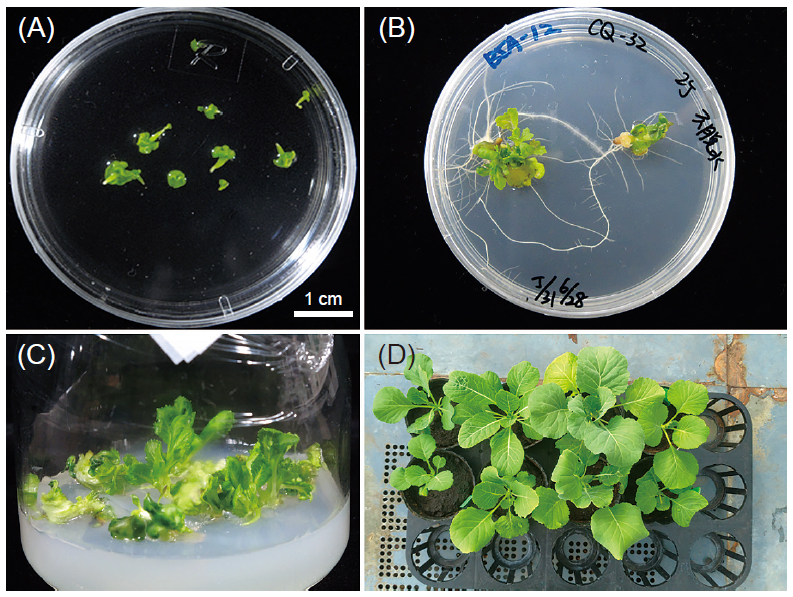All issues

Author:Chi-Ni Hsia*, Uei-Chern Chen, Chin-Yi Tsao, Tzu-Kai Lin, and Ming-Kun Chi
Abstract:
Cabbage (Brassica oleracea var. capitata) is the most important leafy vegetable in Taiwan. In order to shorten breeding process of F1 cabbage, an optimized protocol on microspore culture to produce doubled-haploid (DH) lines has been established in this study. Microspores derived from bud with size of 2.50–3.50 mm or 3.51–4.50 mm were compared. Results showed that the smaller-sized buds had either better than or equal to that of the larger-sized buds on embryogenesis among 14 screened cultivars. The results also showed that 13 out of 14 cultivars responded to embryogenesis induction. Moreover, among them ‘Jin Chuen’ and ‘Shin Wei’ had the highest microspore embryogenesis with 15.89 embryos/petridish and 10.17 embryos/petridish, respectively. An experiment testing 1/2 or full strength NLN salt medium in combination with active charcoal-agarose suspension on microspore embryogenesis was conducted using cv. ‘Jin Chuen’ and ‘Shin Wei’. The results showed that 1/2 NLN was superior to full strength NLN [Nitsch & Nitsch medium modified by Lichter (1981)] on microspore embryogenesis in both cultivars. However, no significant effect of charcoal-agarose suspension on microspore embryogenesis was shown. Types of carbohydrate and its concentration in the microspore medium were tested on microspore embryogenesis including either using 13% sucrose or 13% maltose for 4-wk culture interval, or using 16% sucrose for 2 d culturing before changing to 10% sucrose culturing for the rest of time on embryogenesis. The highest embryogenesis rate was found by using 13% sucrose for all culture interval on both cultivars. Two stages temperature treatments on microspore embryogenesis were also investigated by culturing microspores in the first stage at either 32℃ or 35℃ for 1 d followed by culturing either at 22℃ or 25℃ for 2 wk. The results showed that only the high temperature in the first stage had significant effect on embryogenesis and the highest embryogenesis was observed by 1 d culturing at 32℃ following at 25 ℃ for the rest culturing time. A high embryo germination rate of 91.81% was obtained from ‘Shin Wei’ by desiccating cotyledon stage embryos on a filter paper at 4℃ for 1 wk before subculturing onto the B5 medium containing 16% agar (B5A-16) for germination. However, a low germination rate of 27.77% was obtained from ‘Jin Chuen’ by using the same treatment and no improvement on the germination rate was found by increasing agar concentration in the germination medium from 10% to 16%. An improved high germination rate up to 94.00% was obtained on ‘Jin Chuen’ by directly culturing embryos on the B5A-16 medium without filter paper desiccation at 4℃ for 1 wk before moving to 25℃. Ploidy levels of microspore derived plants were analyzed using flow cytometry and DH rates of 53.4% and 12.5% were obtained for ‘Jin Chuen’ and ‘Shin Wei’, respectively.
Key words:Brassica oleracea. var. capitata, Microspore embryogenesis, Doubled haploid
Download:![]() PDF Links
PDF Links
- 1. Using Digital Soil Mapping to Predict Soil Organic Carbon Stocks in Zhuoshui River Basin
- 2. Development of a Technique for Forecasting (or Pre-Detection) Anthracnose Disease Incidences of Green Mature Bagging Mango Fruits
- 3. Taxonomic Review of the Genus Asiophrida Medvedev, 1999 in Taiwan (Insecta: Coleoptera: Chrysomelidae: Galerucinae: Alticini), with Notes on Biology
 Submit your manuscript
Submit your manuscript
 Guide for authors
Guide for authors